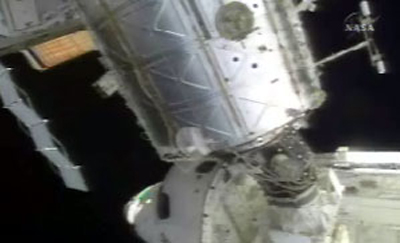Casting Off: Shuttle Discovery Undocks from Space Station

This story was updated at 8:18 a.m. EDT.
HOUSTON - Six NASA astronauts began theirhomeward trek Saturday as their Discovery orbiter cast off from theInternational Space Station (ISS) following eight days of orbital work.
Discovery'sSTS-121 astronauts took some final parting snapshots before they shut thehatches linking their spacecraft to the ISS at about 4:00 a.m. EDT (0800 GMT).
"Thismoment came so fast," ISSExpedition 13 commander PavelVinogradov told flight controllers earlier this morning. "It's alreadyundocking."
Discoverypulled away from its berth at the end of the space station's U.S.-built Destinylaboratory at about 6:08 a.m. EDT (1008 GMT) to begin a planned two-day trip back toEarth.
"We have physical separation," Discovery's commander StevenLindsey said as the 100-ton orbiter pulled away from the 200-ton spacestation 223 statute miles (358 kilometers) up and off the coast of New Zealand.
Aboard theISS, three astronauts watched their departing comrades fly off after a busyweek of reunions and resupply.
Breaking space news, the latest updates on rocket launches, skywatching events and more!
"Have asafe trip, soft landings, and we'll see you on the ground in a few months,"said ISS Expedition 13 flight engineer JeffreyWilliams as the shuttle pulled away.
"And thanks Jeff, we enjoyed it tremendousely and we'll see you back on the ground," Lindsey replied.
Mission's end approaches
Discoveryis slated to land in Cape Canaveral, Florida at NASA's Kennedy Space Center on July 17 at about 9:14 a.m. EDT (1314 GMT). The spaceflight - NASA's secondshuttle mission since the 2003 lossof the Columbia orbiter and its seven-astronaut crew - launchedtoward the ISS on July 4 and dockedtwo days later.
"We've gota great ship," STS-121 pilot MarkKelly, who deftly guided Discovery away from the ISS today, said Friday. "It'sready to come home and we're going to do that on Monday."
In additionto completing NASA's return to flight objectives - which included testing anorbital inspection boom for use as a repair platform and evaluating a heat shieldcrack repair method - Discovery's STS-121 mission also delivered about 7,400pounds (3,356 kilograms) of supplies, science equipment and other necessitiesfor ISS crews.
Discoveryalso ferried European Space Agency (ESA) astronaut Thomas Reiterto the ISS. Reiter joined the Expedition 13 mission as a third crewmember, markingthe first time an ISS crew has reached its three-person capacity since the Columbia accident. Previous crews had been limited to two-astronaut teams.
"I am ingreat spirits," Reiter told reporters in his homeland of Germany Friday. "I'm in a very good mood."
STS-121spacewalkers PiersSellers and MichaelFossum staged threespacewalks outside the ISS during Discovery's eight-day stay, two of whichwere primarily aimed at testing shuttle heat shield repair tools andtechniques.
But a July 10spacewalk featured a critical repair to the station's Mobile Transporter, arailcar-like carrier that moves large components and a robotic arm along theorbital lab's major truss. The fix opens the gate for the next 15 shuttlemissions that will completethe ISS, NASA has said.
"I wish Iwas part poet, and not mostly engineer, because the words escape me," Fossumsaid Friday as he tried to describe the spacewalks and shuttle mission, both firstsfor his astronaut career.
Finalheat shield inspections
Discoverywill hover about 40 nautical miles (74 kilometers) from the ISS today untilafter STS-121 mission specialists LisaNowak and StephanieWilson, as well as Lindsey and Kelly, complete a final check of the orbiter'snose cap and starboard wing leading edge.
The astronautsguided Discovery's sensor-tipped inspection boom through a similar scan of theheat-resistant reinforced carbon carbon panels along Discovery's portwing on Friday, and will finish the survey today. The two-part scan is similarto the intensive FlightDay 2 inspections Nowak and Wilson conducted to verify Discovery's healthfor reentry.
Engineerswill sift through the imagery for any signs of damage from orbital debris ormicrometeorites before giving the orbiter a complete pass to return to Earth,NASA officials said. If image analysts find any concerns, Discovery and itscrew could return to the ISS for safekeeping, they added.
"When wewent through the risks to the shuttle, it was number two on the list," NASA'sdeputy shuttle program manager John Shannon said Friday of micrometeorites andorbital debris. "I feel, for the program, very encouraged that we're takingrisks that we used to think we just had to live with, and are doing positivethings to get us in a better configuration."
Shuttleheat shield follow-up inspections were set to begin about 8:58 a.m. EDT (1258GMT), with the 50-foot (15-meter) inspection boom to be replaced in its flightberth at about 12:28 pm. EDT (1628 GMT), NASA said.
Meanwhile,engineers continue to study a potentialhydrazine fuel leak in one of Discovery's three auxiliary power units. Flightcontrollers plan to test the small leak - which could be either hydrazine orharmless gaseous nitrogen - on Sunday to determine if the APU should remain inoperation during Monday's planned landing.
"I think it'shighly likely we'll end up flying the plan we planned preflight," Shannon said.
- Gallery: Shuttle's First Flight
- Gallery: Rare Space Shuttle Images
- Shuttle Discovery: Complete Mission Coverage
- Great Space Quizzes: Space Shuttle Countdown
- Great Space Quizzes: The Space Shuttle
- Great Space Quizzes: Life in Orbit

Tariq is the award-winning Editor-in-Chief of Space.com and joined the team in 2001. He covers human spaceflight, as well as skywatching and entertainment. He became Space.com's Editor-in-Chief in 2019. Before joining Space.com, Tariq was a staff reporter for The Los Angeles Times covering education and city beats in La Habra, Fullerton and Huntington Beach. He's a recipient of the 2022 Harry Kolcum Award for excellence in space reporting and the 2025 Space Pioneer Award from the National Space Society. He is an Eagle Scout and Space Camp alum with journalism degrees from the USC and NYU. You can find Tariq at Space.com and as the co-host to the This Week In Space podcast on the TWiT network. To see his latest project, you can follow Tariq on Twitter @tariqjmalik.
